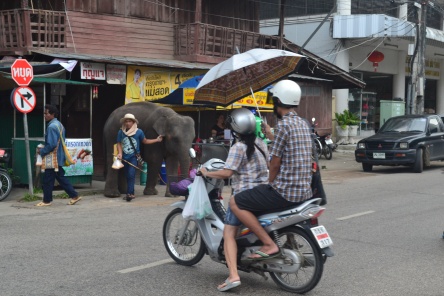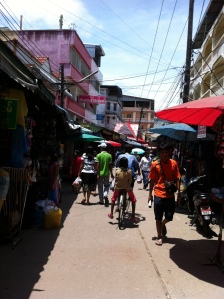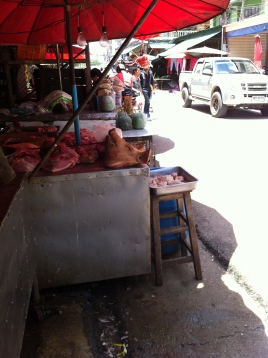Mae Sot is not your typical tourist destination; you could call it “off the beaten track” if it weren’t for all the expats. Located on one of the borders between Thailand and Burma, Mae Sot attracts tens (maybe hundreds) of expats – volunteers and relief workers alike – mainly to help the refugees who escape from Burma, penniless and terrified, only to land in Thailand and find out that they are not welcome.
I’m going to get a little bit political for a moment – Thailand is not a signatory to the 1951 Refugee Convention, meaning – in practice – that it does not grant asylum status to the thousands who flee from Burma (Myanmar) every year. This renders people effectively stateless, as the choice they are faced with is to return to Burma – where their villages may have been burned down and they are at risk of being killed by the military – or staying in Thailand on the condition that they stay inside one of the designated refugee camps. This means that the Burmese living on the borders, e.g. Mae Sot, are technically illegally resident. Some have tried to escape into Thailand, but they are likely to be stopped and have their papers checked along the way. Things are getting “better” now that Burma has started opening up to the West, but this is mainly an economic thing – a great deal of horror is still happening within Burma, and it’s only the UN’s reluctance to name it genocide that stops other countries from intervening. Anyway. There are a lot of good people who come to Mae Sot to volunteer, and as Jeff is keen to get into the field of international development/human rights, we thought it would be a good place to visit.
Despite not being on the tourist trail, several buses service the 8-hour link between Bangkok and Mae Sot. The buses leave from Bangkok’s Mo Chit bus station, and you can buy your tickets there. However, being organised (e.g. terrified of ever being lost/late), the day before we set off to Mae Sot I asked the receptionist at the Cozy Bangkok Place about booking a ticket. This lovely lady made some phone calls for me, found a company called Thai Ticket Major who travels between the two, and booked us two tickets over the phone. She then gave us a number to take to the nearest 7-11 and wrote a message on the piece of paper explaining that we wanted to pre-pay for our bus tickets. We took this message to 7-11, who were able to process the payment and give us our receipts there and then. Efficient!
When we arrived at Mo Chit Bus station the next morning (41 baht by taxi from the metro stop Kamphang), we were overwhelmed by the number of ticket booths. It seems that there are about 60 ticket windows, each one only providing tickets to certain destinations. I believe that you can travel on a “normal” bus if you find the right ticket window, but foreigners are usually guided to the “VIP” buses. These buses are normally operated by companies with English writing and flashy colours. From what I have heard, the “VIP” buses are a rip-off. The better option is to find a “first class” bus, whatever that means, usually run by an operator with a tiny bit of English writing on their sign but nothing too fancy. These buses are similar to National Express, Megabus etc… several companies might run to the same destination, and while there might be a tiny difference in price the main deciding factor will be the times that they leave and arrive. It turns out that there were several buses to Mae Sot, running all day from various companies.
We found the ticket booth for Thai Ticket Major (a black booth with red letters) to the immediate right (on the wall next to the door we entered), gave them the receipts from 7-11 and were given our tickets. The bus ticket cost us 428 baht with a 20 baht service charge, so basically £9 for an 8-hour bus journey on a comfortable, air-conditioned double decker bus (with a toilet). They provided us with a bottle of water and a small snack. The seats reclined all the way back to horizontal (PLEASE don’t do this if someone is behind you), you were given a small blanket in case the air-con was too cold, and halfway through the journey we stopped at a service station in which we could use a tear-off piece of our ticket in exchange for a hot meal. There were a few choices – noodle soup, curries, various unidentifiable dishes – plus a little shop where we could stock up on snacks and water.
It’s at times like these, at the service stations, that you’ll encounter the more traditional type of Thai toilet. Don’t be afraid. The traditional Asian toilet is not a seat, but a hole in the ground over which you squat (facing away from the door, towards the back wall) and do your thing. At least the ones at service stations are porcelain bowls. Thais don’t use toilet paper, and their toilets certainly can’t process it. Even in the nicest hotels, you should put your toilet paper in the bin next to the toilet. A lot of these places won’t have bins. Toilets will have either a hose or a bucket full of water next to them. The practice is to use this water to wash yourself. Yes, that means you’ll be walking around with a wet bum, but it’s not always as bad as it sounds. Secondly, while more modern toilets have a flush, older ones require you to flush them yourself, by throwing a couple buckets of the water next to the toilet down the bowl. This is what you’ll find at the service stations. Just be prepared, get over your Western squeamishness and preconceptions of hygiene, and maybe bring some hand sanitiser (if it makes you feel better).
The journey to Mae Sot is long but beautiful. For a good proportion of the journey you’ll find yourself ascending higher and higher into the mountains, wondering how the bus manages to pull itself up. Your ears may pop, you’ll be surrounded by trees and a feeling of “tropicalness”, and on your descent back down towards Mae Sot you’ll start to see real villages and bamboo huts. Oh, and your bus will be stopped by border control, to make sure there are no illegal immigrants on board. They’ll be super nice to you, even if it’s two seconds before they grab some poor, shaking guy who didn’t have the right paperwork and drag him off the bus.
When we arrived at Mae Sot, there were plenty of tuk-tuk drivers just waiting to drive us to our destination. We were staying at the Baan Kiang Chang (found through booking.com or something similar) and, being over-prepared, I had drawn a map and copied down the name in Thai. I said the name to one of the drivers and he knew where it was, so off we went on the spluttering little tuk-tuk, past Mae Sot’s Tesco (yep, there’s another Tesco) and to the hotel. The ride cost 100 baht, which was probably way more than any local would ever pay, but oh well. The hotel itself was beautiful – around £10 a night for a massive room with a bath, and breakfast included. I’d recommend it, apart from one thing – if you’re going back there after dark, it’s down a bit of a dark, scary road. I’ll tell you what’s so bad about that in a minute. The hotel is here (https://maps.google.com/maps?q=16.722954,98.561311&ll=16.722378,98.562362&spn=0.007388,0.012724&num=1&t=m&z=17) and it’s even on Street view now!
Getting around Mae Sot is a little tricky. Your options are to spend a fair bit on tuk-tuks (if you can find one), walk or rent a bicycle or motorbike. That main road that you’ll see on Google maps (the yellow one) is where you’ll find Tesco, but it was also home to an excellent little market. It was just west the road leading to our hotel and was there every Saturday – fortunately for us, we were there on a Saturday, meaning that I was able to buy a dress for 200 baht and a box of delicious noodles for 10 baht!
Our main aim was to find some of the expat volunteers and workers and chat to them about life out in Mae Sot. We had heard that Mae Sot had a Canadian bar and were eventually able to find it. Don’t try using Google maps to search for it – it led us into the middle of a residential street. I eventually had to call the number that was online for it to ask where it was. I’ve used street view and can show you:
The bar serves Mexican, American and British food as well as classic Thai dishes, and also provided some pretty good smoothies and cocktails. Within ten minutes I had met a guy from Merthyr Tydfil who spoke fluent Thai, and a guy around my age who had grown up between Mae Sot and the UK due to his parents’ job. They suggest that we walk a little further up the street and try a bar called Expacct, which is where the expats congregated. We wandered on down and found an outdoor bar with no customers. We sat ourselves down, ordered some drinks and snacks, and were joined by two cats. After a while, an American girl sat near us. We got chatting and found that she had just moved to Mae Sot to work for a charity and didn’t know anyone. A few drinks later and the two big tables were chock-full of expats. We decided to introduce ourselves and spent the evening chatting to random people. Eventually, they started to head off on their bikes and were horrified to learn that we planned to walk back to our hotel. That’s when we found out about the street dogs.
There are stray dogs all over Thailand, but they mostly look quite harmless. We were told that, at night, Mae Sot’s dogs collect in packs and harass people. Some have even been known to bite people. One of the guys we met there kindly drove us back to our hotel.
We mostly wandered around the next day, to see what Mae Sot had to offer. I found a man walking a young elephant around, charging 20 baht for a bag of bamboo to feed him. This was a small elephant and felt much less “touristy” than Thailand’s usual relationship with elephants, which can feel pretty exploitative. We also headed a little further “south”, a couple of blocks south and west from the Canadian bar, to find some of the Burmese markets. As I’ve said, due to the proximity to the Burmese border, Mae Sot is actually quite a melting pot of cultures. The Burmese alphabet was suddenly all around us, people walked around with the yellow “thanaka” (it’s a type of sun block/beauty product, I think) on their faces, and the vibe was quite different from what we’d seen of Thailand so far (which, admittedly, was mostly just Bangkok).
Pictures can be worth 1000 words, so here are some of the things we saw…
Market life seems a core part of life in South East Asia, with far fewer big chain shops and malls outside the big cities (apart from that pesky old Tesco Lotus). It’s impossible to walk through them without feeling an overwhelming sense of colour, to feel the social buzz, the life. This is partly caused by the adrenaline that flows through you when yet another motorbike squeezes past you on a 2′ path.
We took a break at the Lucky tea garden (look for a green Islamic flag), where we got some tea and samosas for around £1 while a happy child swept the floor, a couple flies buzzed around us and we watched people shopping and motorbikes zooming past. It was then that I noticed a bottle of bright green Fanta in the drinks fridge. Could it be? I ordered it and, low and behold – melon Fanta!!! Yes, it looks radioactive and is about as good for you as a hammer to the face, but we had been addicted to the stuff in Japan and led to believe that melon was a flavour only available in Japan and Israel. But, here it was in Mae Sot. Jeff decided immediately that we had to move there at once.

Don’t miss the random Ganesh statue on your walk back:
After a nap (walking around in that heat is hard work) we decided to check out Borderline – a café and fair-trade handicraft shop & art that supports Burmese migrants and refugees. Their website displays the artwork and handicrafts produced by Burmese migrants, and their shop also sells documentaries on books highlighting the many problems faced by the Burmese (we bought a lot of these documentaries!). Their café sells Burmese food and they run Burmese cooking courses. I wish we had done one of these, because this was the first time we tried Burmese food – tea leaf salad, potato curry and some cake-y snacks and… let’s just say we are obsessed with Burmese food now. We actually order the tea leaves every few weeks from Mum’s House, a Burmese import store in London, and I’ve bought a magnificent Burmese cooking book called Burma: Rivers of Flavour. While browsing their shop, we met a British guy who actually a doctor volunteering at a malaria clinic near the border. It was one of his last nights and he had never heard of the jungle restaurant that we intended to go to. So, in the spirit of travel, we invited him along and met up later that evening.

The jungle restaurant – Khao Mao-Khao Fang – is a little ways out of Mae Sot proper. You wouldn’t want to walk there – it’s about 10 minutes on a motorbike. We found this out because, after meeting our friend, we tried to find a mode of transport. We walked around for fifteen minutes trying to find a taxi, even walking into hotels and the local 7-11 and saying “taxi?” to be met with confused stares. Finally, two guys with motorbikes told us that they were motorbike taxis and that they would drive us to the restaurant for 200 baht total. I had never been on a motorbike before, and had to brace myself as I was sandwiched on a motorbike between two men I’d just met. I didn’t have a helmet and, in Thailand, you don’t put your arms around the waist of the person in front of you like they do in the movies – you just kind of hold on to the side of the bike, or nothing at all. You’ll see people just chilling on the back of bikes as if nothing could go wrong, sometimes while doing their make-up; but the real treat is when you see families of four or five crammed onto one bike, maybe with a few items strapped onto the back for transportation.
The jungle restaurant certainly has beautiful décor – all the charm of the jungle without the danger or mosquitoes. The food is a little overpriced, nothing too special in the grand scheme of things, but we had a nice time. The most memorable part of the evening was watching a waiter trying to sweep a live frog into his dustpan and brush, before throwing the poor thing into the bin!
If you’re wondering how we got back, this is why getting a Thai SIM card is handy. The driver gave us his number and made it clear for us to call him when we were ready to leave. They drove us back, but tried to charge us 300 baht total as there were three of us. We refused to cave, as they had ensured us that it would be 100 baht per bike. Ah well, at the end of the day you might feel like a bit of an idiot arguing over £2, but when you’re constantly seen as a walking ATM it’s a little draining.
On our walk back to the hotel, we realised why the dogs are so feared. We’re normally great dog lovers, but imagine you’re walking down a dark street and you suddenly hear a menacing howl, following by a chorus of rapidly encroaching, feverish barking. It’s pretty hard not to freak out and burst into a run, but we stayed calm, shone Jeff’s phone torch at them and kept walking. They kept their distance, luckily, but it was a scary experience. If you’re staying there, get a bike of some sort so you can get away from them.
The next morning, our hotel’s free tuk-tuk drove us back to the bus station for 8am, where we were able to buy a bus ticket to Chiang Mai. If you’re interested in the Thai-Burma border situation at all, I recommend you read “For Us Surrender is Out of the Question” by Mac McClelland. It’s an engaging, well-written account of a volunteer’s six-week stint in Mae Sot, full of the history of Burma. In her book, you can learn about how Britain contributed to the mess that they’re currently in, how the right amount of money can bribe a Thai police officer to do almost anything, and just how wide the cultural gaps between people can be (at first, at least).










Thank you for working such a thorough account of your time in Many Sot. My husband and I have considered visiting Thailand and stumbled across your blog while researching Mae Sot. This was incredibly helpful!